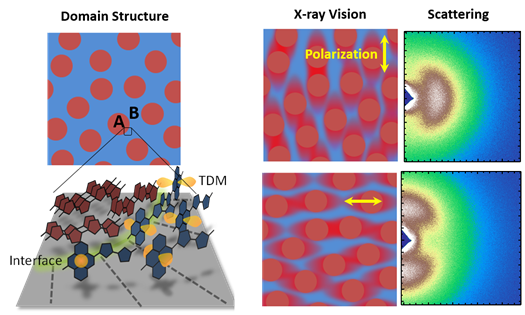Synchrotron X-ray Facilities
Advanced Light Source at Berkeley National Laboratory
- Beamline 5.3.2 Scanning Transmission X-ray Microscope
- Beamline 6.3.2 Resonant Soft X-ray Reflectivity (R-SoXR)
- Beamline 7.3.3 Grazing Incidence Small and Wide Angle Scattering (Hard X-ray)
- Beamline 11.0.1.2 Resonant Soft X-ray Scattering (R-SoXS)
The Australian Synchrotron
Near Edge X-ray Absorption Fine Structure (NEXAFS) Spectroscopy
Concept of NEXAFS
When the X-ray is tuned to the carbon’s (or other element’s) K-absorption edge, an electron absorbs the energy and is promoted to a higher molecular orbital. This occurs at precise energies that depend on the molecule’s bonding arrangments. Thus fine resonances occur in the molecule’s absorption spectra in a pattern that is specific to each molecule. This allows for the easy identification of the molecules in a composite such that one can extract precise composition through fitting analysis.
NEXAFS Fitting Analysis
Scanning Transmission X-ray Microscopy (STXM)
Similar to a Scanning Transmission Electron Microscope (STEM). This microscope focuses the X-ray beam down to <50 nm and scans the sample, monitoring the transmitted beam. If each image is acquired at several energies across an absorption edge in the style of NEXAFS, quantitative composition maps can be obtained.
STXM Composition Analysis
Resonant Soft X-ray Scattering (R-SoXS)
R-SoXS Setup & Data
Currently this technique is conducted in transmission mode similar to Small Angle X-ray/Neutron Scattering (SAXS/SANS), using a large collimated beam and CCD detector. By tuning the X-ray energy to a resonance, film domain structure is revealed. Off-resonance, the scattering pattern comes primarily from density differences such as surface roughness or voids/porosity. In multi-component composites, domains can be identified through hyperspectral measurement of the scattering pattern across an absorption edge.
An origin of Polarization-Induced Scattering Anisotropy (PISA)
Using polarized X-rays, often the scattering patterns from isotropic films become anisotropic at the absorption edge. This is due to the dipolar nature of the transitions associated with absorption. If there is bond or molecular alignment at interfaces within the sample, then anisotropic scattering patterns can emerge. This polarization-induced scattering anisotropy (PISA) can be useful in extracting such ordering information from within the bulk of pure or composite organic films.
Grazing Incidence Wide Angle X-ray Scattering (GIWAXS)
GIWAXS setup and data
GIWAXS is primarily a diffraction technique to measure the crystalline characteristics of these semicrystalline materials. The technique is sometimes referred to as Grazing Incidence X-ray Diffraction (GIXD). If the molecules pack with sufficient regularity, they will diffract and properties such as crystal orientation, size, population, and disorder can be extracted from these data. Certain crystalline characteristics can often be correlated with charge transport in these materials.








